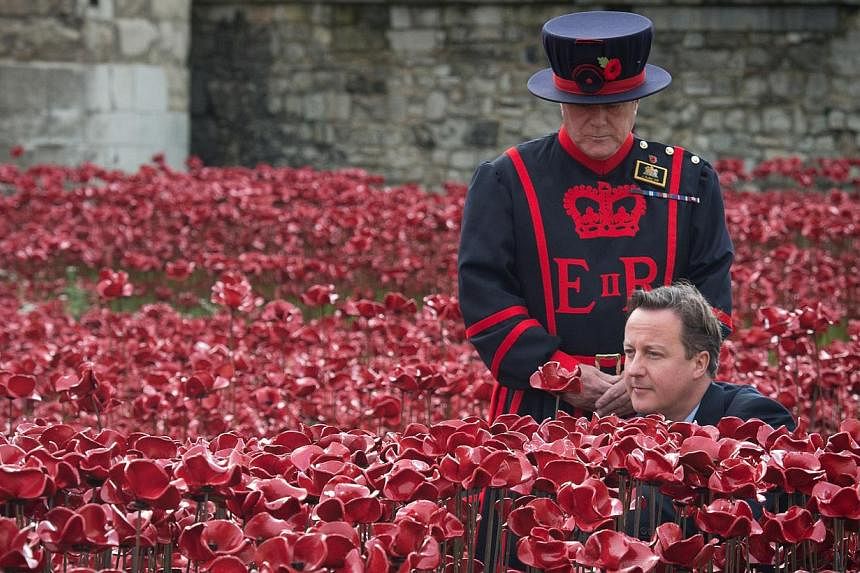LONDON (AFP) - Designed as a tribute to Britain's World War I dead, a blood-red trench of ceramic poppies around the Tower of London has become a national phenomenon as Britons flock to remember the fallen in generations of war.
Up to four million people - 6 per cent of the country's population - are expected to visit the exhibit dubbed "Blood Swept Lands And Seas Of Red" before the last flower is planted on Tuesday on the anniversary of the end of World War I.
The poignant display is now also one of London's busiest tourist attractions as 888,246 poppies, one for every British soldier who died in the conflict, have been progressively planted in the tower's moat since August.
Older visitors bring their own memories of wartime while younger ones remember relatives killed in conflict, as they edge politely to the front of the crowd to pose for selfies.
"We lived through World War II - I was six when the war broke out - my grandfather was in World War I and was gassed three times, so I have quite a lot to think about," said Ann Household, 81, who had travelled from the southern coastal town of Eastbourne to see the exhibit.
"It's affected every generation of our family."
Her husband Graham explained that his sister, Dorothy, was killed by an Irish Republican Army (IRA) bomb at the Tower of London in 1974 - "so we have another connection".
"If anything tells you about the crazy futility of war, it's this," the 79-year-old added quietly, gesturing at the sea of red surrounding the tower.
"We always get involved - why do we always get involved?"
At peak visiting times, officials have had to close the nearby Underground station due to overcrowding, but organisers have resisted calls from politicians and the public to keep the exhibit open longer.
It will start being dismantled on Wednesday and the poppies have been sold off to raise money for military-related charities, although a section of the exhibit will eventually go on permanent display at the Imperial War Museum.
The poppy has been a symbol of remembrance for Britain's war dead since the flowers grew on the battlefields of northern Europe during the 1914-18 "war to end all wars" which killed 10 million troops.
This year's Armistice Day carries particular resonance as it comes 100 years on from the start of the Great War and the withdrawal of British combat troops from Afghanistan after 13 years.
Millions of Britons wear a paper poppy pinned to the lapel of their coats every year to remember the war dead.
Stephen Nylan, a 28-year-old dancer sporting pierced ears and red Dr Martens boots who was visiting the Tower of London display, had two - a paper one pinned to his chest and a knitted one on his rucksack.
"We want to get a glittery one next year," his friend Claire Cranmer explained.
She had come because she wanted to buy a ceramic poppy in memory of her war veteran grandfather, who died this year.
But the poppies sold out last month, and eBay has banned their sale from the online auction site by traders cashing in on the memorial's popularity.
Voices questioning the symbolism of the poppy are rare, although newsreader Jon Snow has previously denounced "poppy fascism" which he said dictated that broadcasters had to wear them on TV.
The Guardian newspaper faced a Twitter backlash last month when it ran a piece by art critic Jonathan Jones arguing that the Tower of London display did not reflect the full horror of war.
"In spite of the mention of blood in its title, this is a deeply aestheticised, prettified and toothless war memorial," Jones wrote.
Anti-war protesters from the Stop The War Coalition have urged people to wear white poppies instead "to put peace at the heart of remembering those who died in war".
Outside the Tower of London, built in 1078 by William the Conqueror, foreign visitors were impressed and curious about Britain's poppy-wearing tradition.
"It reminds us a little bit of the USA because of the emotions," said Brunhild Weiss, a retired teacher from Bremen in Germany.
"I'm not sure if I would want it in Germany. It depends on the aim."

